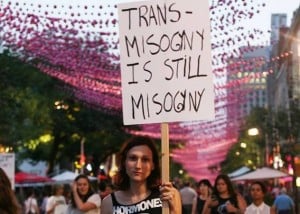Originally published on The Body Is Not An Apology and republished here with their permission.

Source: iStock
What is gender, anyway?
Gender is a social construct. What I mean by that is the ways in which characteristics, interests, and behaviors are deemed “masculine” or “feminine” relies on people creating, believing, and reinforcing these divisions.
The things we have been taught divide men and women are not innate differences.
Lori Girshwick, author of Transgender Voices, defines social constructivism as the idea that “we are in charge of our perception of reality and that we hold the means to create, reinforce, or alter that perceived reality,” and that “what we perceive to be real becomes real in the sense that it has real consequences, whether or not it is the truth.”
Although gender markers may not be innate, they still have a real effect on our lives as we live within this gender system. In Western/European society, gender is a collection of socially constructed markers that allow us to distinguish between men and women, as well as assign roles and values to these two groups.
Gender! What Is It Good For?
Although gender has not looked the same in all places, at all times, during the last few hundred years (and under Western influence), gender has become widely divided between two opposing options.
If you are male, you must look, act, and dress according to a certain set of rules. If you are female, you must look, act, and dress according to a different set of rules.
In our patriarchal, cisnormative, binary society, gender is a form of categorization and social control. It tells us how to treat and respond to others (similar to other identity markers, such as race, class, and ability). Our learned responses to gender cover a wide range of interactions.
One more innocent example is holding a door open for a woman, or pulling back her chair. It can also look like labelling a woman’s emotions irrational when she becomes upset.
On the extreme end of the spectrum, this response could be committing violence against a trans woman, or a gender non-conforming person.
In addition to the sexism that women face in our patriarchal gender system, the rigidity of the gender binary punishes people who do not fit into gender expectations. This comes out in transphobia.
Trans women face both sexism and misogyny as women and as trans people, existing at a particularly perilous intersection of identity.
The Markers (and Pencils, Crayons…) of Gender
In our cisnormative world, we are taught from birth about the things that divide and define men and women. It can be hard to step back and see that those deeply engrained markers are socially constructed, not inherent to being a man or a woman.
In her book Gender Outlaws, Kate Bornstein explores some of the social markers through which gender is communicated and determined:
“Physical cues include body, hair, clothes, voice, skin, and movement . . . [b]ehavioral cues include manners, decorum, protocol, and deportment . . . [t]extual cues include histories, documents, names, associates, relationships – true or false – which support a desired gender attribution . . . [m]ythic cues include cultural and sub-cultural myths which support membership in a given gender.
“This culture’s myths include archetypes like: weaker sex, dumb blonde, strong silent type, and better half . . . [p]ower dynamics as cue include modes of communication, communication techniques, and degrees of aggressiveness, assertiveness, persistence, and ambition,” Bornstein writes.
Although all of these markers are constructed socially, that doesn’t mean that the stories we are taught to read through these markers does not have an effect in our lives.
By pointing out these various components, I’m hoping to point out that many of the things we use to view and define gender are taught to us and can be consciously expressed or rejected.
The way we understand and view gender as a binary of male or female is not inherent or fixed.
Breaking Down Gender
Gender is a complex and layered concept that reaches deeply into every aspect of our lives, from our clothing to our interactions, into our personal and collective histories and myths.
Gender is a difficult concept to pin down, built as it is with so many subjective pieces.
In order to dig into it a little bit more, I’m going to break up gender into several different categories to explore, including gender roles, expression, attribution, and identity.
Gender Roles
Kate Bornstein defines gender roles as the “collections of factors which answer the question, ‘How do I need to function so that society perceives me as belonging or not belonging to a specific gender?’”
Girshwick defines gender roles as “the behaviors, and ways of thinking and feeling, that the culture teaches are appropriate for the two genders.”
Gender roles have changed over time, and the roles that still exist are less fixed and less strict; these days, it’s more acceptable for women to take part in masculine-coded activities such as sports, politics, construction, and fighting.
Men are still more stigmatized for doing things deemed feminine, which is a testament to the misogyny in our society. However, almost everyone accepts that it is both possible and acceptable for women and men to do at least some things considered masculine or feminine.
Some stereotypical gender roles for women include raising children, taking care of the home, and taking on caregiving roles in general.
Some stereotypical roles for men are pursuing a career, protecting their families, or being physically strong.
Gender Expression
Gender expression is “the way an individual chooses to present [their] gender to others through dress, speech, actions, and grooming,” writes Girshwick.
Some tools of gender expression include haircuts, growing or shaving body hair, makeup, clothing, accessories, possessions, and how we talk, move, and interact with others. Some pieces of gender expression can come to people naturally, while other parts can be forced upon a person.
For example, I have always been most comfortable in baggy, loose clothing and I like having short hair. In high school, however, I was told these were things boys wore and I should wear different, more form-fitting clothing, as well as grow my hair out.
All of these and other tools of gender expression can be used or discarded to provide comfort or help people be viewed as a certain gender by other people.
Gender Attribution
Gender expression is closely linked to gender attribution, which is when someone looks at a person and decides whether they are a man or a woman based on the cues given to them by the person in question.
Outside of transgender groups and their allies, attribution in our society always operates inside a binary framework – the attributee is always either a man or a woman, never neither or both.
Additionally, gender attribution is immediate, and any confusing cues can result in discomfort or even a violent reaction on the part of the attributer.
It can be difficult for trans people to be seen as the gender they identify with for a multitude of reasons. They may not have the time, money, or ability to change their expression. They may not want to change certain things (or anything) about themselves in order to be more in line with what cis society expects.
They may be non-binary and cannot pass as their gender in a cisnormative society no matter how they dress or express themselves.
Furthermore, there is no completely “right” way to do a certain gender. There are cues that we have come to see as male or female, but one cannot do every marker of a certain gender because there is no ideal set of gender markers.
Through various forms of media, we have been given idealized images of men and women our entire lives – images of people who are white, thin, straight, able, and on the extreme ends of masculinity and femininity.
But no one, including cis people, embodies these impossible standards. Cis people don’t have to embody all the right markers of a certain gender to be respected as that gender, and neither should trans people have to.
This means cis and trans people can express their genders however they want and it does not affect their gender identity.
Gender Identity
The only meaningful way to determine gender is through personal gender identity, which is “an individual’s internal sense of gender” by Girshwick’s defining.
The only way one can know someone else’s gender identity is to ask and listen to them!
Girshwick writes that we “communicate our gender identity through gender roles and gender presentation, which often follow the gender norms of the culture,” but I hope it is clear now that that is not always the case.
Even for cisgender people, the level to which someone is masculine or feminine does not necessarily reflect their gender. This disconnect between expression and gender can be true for transgender and non-binary people as well – a trans woman can be as masculine as she pleases, and a trans man can be feminine. It does not affect their gender identity.
This is a difficult concept to grasp as the main ways our society denotes gender is by feminine or masculine expression.
But gender, sex, and expression are not inherently linked.
The only meaningful way to establish gender is through personal gender identity – the gender one feels oneself to be.
How Do We Know Our Gender(s)?
This can be a difficult question for many, as the answer has been taught to us since birth. It seems self-evident.
For me, when I was younger, it seemed obvious I was a girl because I was told I was a girl, I had a different body than boys, and that’s the only option I knew I had.
But when I learned that there were more than two options, I looked inward and couldn’t connect with being a girl or a boy. I found something else and nurtured it.
Many people, after exploring their feelings about their identity, expression, body, and relationships with the world, discover that they are not comfortable with the gender they were assigned at birth and choose to move to a different gender and use different words and ideas (and clothes, etc) to express themselves.
The Social Construction of Sex
Some people find it useful to divide gender and sex. This explanation usually goes along the line of “gender is in your brain, and sex is between your legs.”
This opens up more possibilities for gender while explaining the seemingly binary differences between male and female bodies.
However, this isn’t a helpful distinction in the long term for a couple of reasons.
To start, sex is much less binary than we are taught.
Sex is not a binary.
Many people, when presented with the idea that gender is mutable, would point to the seemingly binary nature of sex.
There are two sets of genitals, gonads, chromosomes, and different sex hormones. It can seem intuitive that these differences would lead to behavioral and social differences.
However, sex is more complicated than a simple binary of male or female, and there are many intersex conditions that complicate the belief that biology is binary and leads to a “true” gender.
As intersex people show, not only are a wide range of genital variations possible and natural (which are often surgically changed based on social perceptions of how big and small penises and clitorises should be), but people can also have a variety of “abnormal” chromosomes, a mixture or the “opposite” kind of internal gonad tissue, and varying levels of hormones (Kessler and McKenna).
Intersex conditions are much more common than people would think. According to Girshwick, “one in 100 births “deviates” from what we expect in terms of male and female bodies.”
Even in dyadic (non-intersex) people, there are no completely distinct sex categories.
As Girshwick explains, “real variation exists in every measurable attribute used to assign the categories of ‘male’ and ‘female’ to bodies. Facial hair, voice pitch, hormone levels, chromosome makeup, internal reproductive organs, external genitalia, as well as people who are intersex all prove that ‘biology’ is not a clear-cut basis for category and offers faulty criteria for determining a gender binary” (Girshwick 33-34).
With all the variation in bodies and in expression, it becomes less useful and more oppressive to hold up two sexes as an objective reality.
Sex is always already gender.
The words “male” and “female” come pre-loaded with socially constructed ideas about maleness and femaleness.
You can’t separate sex from gender by describing gender as in your brain and sex as in your pants because the categories “male” and “female” come with so much attached to them that you’re not really just describing a body type.
Using male and female to refer to trans people’s bodies allows for arguments along the lines of “well, you may feel like this gender, but you’re really this sex and nothing will change that.”
It can also create hoops for trans people to jump through in order to be respected as their true gender.
Many cis people believe that trans people aren’t really their gender until they’ve transitioned through hormones and surgeries. The thing is, trans people genders are valid from the moment they identify as a new gender.
It shouldn’t take jumping through hoops in order to conform to what cis society expects of male or female bodies to achieve respect for our identities.
What should we do instead?
I don’t believe using male and female to refer to someone’s sex assigned at birth is necessary for any conversation in which we talk about people’s bodies.
We can talk about people’s different body parts and needs without using male and female, especially considering the wide variety of bodies and needs out there.
For example, trans people who are on hormones or have had surgeries will need different care from their doctor, care that won’t fall under their sex assigned at birth. In this and other scenarios, discussions can be individual and specific.
How Gender Norms Maintain Hierarchies of Power
Gender is a social construct that assigns roles and values based on certain biological markers, as well as behavior and appearance. It is only this construction that renders non-normative genders as invalid or freakish.
Girshwick writes that “[w]hat we believe – how we think about ourselves, our relationships, our social world – has less to do with scientific or biological ‘facts’ and more to do with profound familial, cultural, and social training that reinforces what is considered ‘normal.’”
This construction of the norm is important because it maintains “sets of hierarchical political structures, economic systems, and social conventions that benefit those at the top of the pyramid,” and it is because of this power structure that the idea of “normal” remains dominant, no matter how many people do not identify with the norm.
Power relies on subjugation, and the norm relies on deviance to define itself in opposition to.
In this way, the social construction of gender not only erases possibilities outside of the binary and creates subjective categories that everyone must fit into, but oppresses those who fall outside of this norm.
Binary gender and the connection of binary sex to gender identity and expression are constantly enforced by our cisnormative society.
In the hundreds of media images people are exposed to every day, two genders are always the only options presented, often to the feminine or masculine extreme, and if transgender people appear at all, they appear as freaks, jokes, and rejects.
Gender norms are also enforced by the government, legal system, schools, religious groups, family, social groups, and other systems.
We are bombarded with these binary images and messages and trained into a binary view and language of gender from birth, and then, in turn, we contribute to the construction of the binary system and its power.
It can be hard – in fact, basically impossible – to figure out if one doesn’t fit in the gender binary when those are the only options presented, and the only language available to discuss gender is binary and linked to biology.
But when given new options – like genderqueer, bigender, androgyne, neutrois, agender, butch, femme, boi, grrl, demiboy, and demigirl – suddenly a world opens up where one can explore to find a word that feels right to describe one’s gender.
Because in the end that’s the only marker of gender one can have – what feels right.
Most cisgender people don’t realize that they also self-identify as their gender. Since society validates cisgender identities, being cis appears “natural” while transgender and non-binary people’s genders seem “unnatural.”
If we can shift our viewpoints and see that sex and gender are much more fluid than we have been taught, then the wide world of gender identities becomes equally valid.
***
This article has just been a starting point. Gender is a widely thought, talked, and written about concept and I have barely begun to dig into the surface, both in this article and in my own learning.
When writing this article, I felt some trepidation at trying to create a Gender Identity 101. I want to be open about my blind spots, privileges, and ignorance so that it is clear to everyone reading this article that I am not an expert on this subject, nor are my words the only viewpoints out there.
I am speaking from a white, able, upper-class experience; race, ability, and class all intersect and affect people’s experience of gender and gender-based oppression.
Furthermore, since I am not a trans woman, I don’t experience transmisogyny and can’t speak to its effects on gender except by reading and sharing what trans women have said about it.
I’m hoping, however, that I have created a jumping off point for the community to talk about gender by reading this article, interrogating it, and adding to it. I encourage readers who are just beginning to learn about the complexity of gender to continue learning about it and to seek out other voices with different perspectives.
[do_widget id=’text-101′]
The Body Is Not An Apology is an international movement committed to cultivating global Radical Self Love and Body Empowerment. We believe that discrimination, social inequality, and injustice are manifestations of our inability to make peace with the body, our own and others. Through information dissemination, personal and social transformation projects and community building, The Body is Not An Apology fosters global, radical, unapologetic self love which translates to radical human love and action in service toward a more just, equitable and compassionate world. Follow on Facebook or Twitter @radicalbodylove.
Search our 3000+ articles!
Read our articles about:
Our online racial justice training
Used by hundreds of universities, non-profits, and businesses.
Click to learn more




















